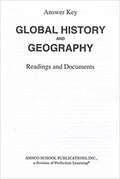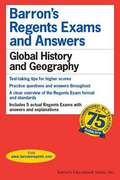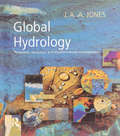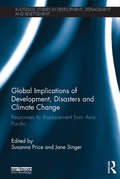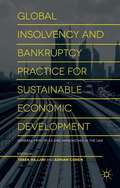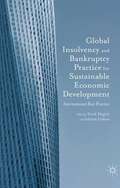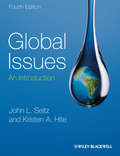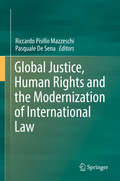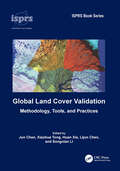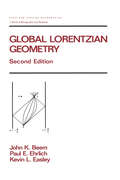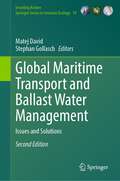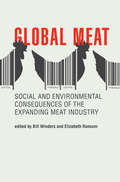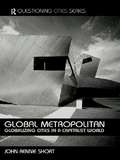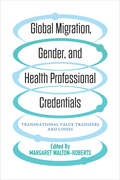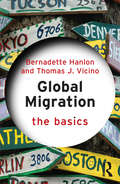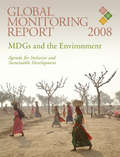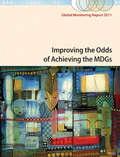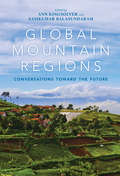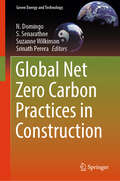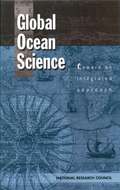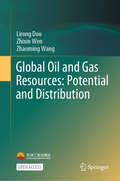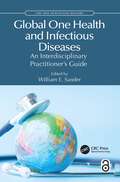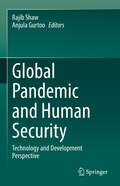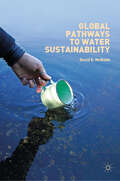- Table View
- List View
Global History And Geography Readings And Documents
by Norman LungerGlobal History and Geography: Readings and Documents
Global History and Geography
by Michael J. Romano William Streitwieser Mary MartinThis edition includes the most recent Global Studies/Global History and Geography Regents tests through August 2015. These ever popular guides contain study tips, test-taking strategies, score analysis charts, and other valuable features. They are an ideal source of practice and test preparation. The detailed answer explanations make each exam a practical learning experience.
Global Hydrology: Processes, Resources and Environmental Management
by J. A. JonesGlobal Hydrology illustrates in detail the growing importance of understanding hydrological processes and pathways as a means of effective and safe management of water resources. It describes current management practices and past environmental impact. It analyses the options for improving water supply and protecting the environment, emphasizing the need for international collaboration in a changing societal and environmental context
Global Implications of Development, Disasters and Climate Change: Responses to Displacement from Asia Pacific (Routledge Studies in Development, Displacement and Resettlement)
by Susanna Price Jane SingerDisplacements in the Asia Pacific region are escalating. The region has for decades experienced more than half of the world’s natural disasters and, in recent years, a disproportionately high share of extreme weather-related disasters, which displaced 19 million people in 2013 alone. This volume offers an innovative and thought-provoking Asia-Pacific perspective on an intensifying global problem: the forced displacement of people from their land, homes, and livelihoods due to development, disasters and environmental change. This book draws together theoretical and multidisciplinary perspectives with diverse case studies from around the region – including China’s Three Gorges Reservoir, Japan’s Fukushima disaster, and the Pacific’s Banaba resettlement. Focusing on responses to displacement in the context of power asymmetries and questions of the public interest, the book highlights shared experiences of displacement, seeking new approaches and solutions that have potential global application. This book shows how displaced peoples respond to interlinked impacts that unravel their social fabric and productive bases, whether through sporadic protest, organised campaigns, empowered mobility or; even community-based negotiation of resettlement solutions. . The volume will be of great interest to researchers and postgraduate students in development studies, environmental and climate change studies, anthropology, sociology, human geography, international law and human rights.
Global Insolvency and Bankruptcy Practice for Sustainable Economic Development: International Best Practice
by Adrian Cohen Tarek HajjiriThis book is a comparative study of international practices in bankruptcy law, providing perspectives from a variety of specialisms including practitioners, lawyers, bankers, accountants and judges from the United Arab Emirates, the UK and Singapore.
Global Insolvency and Bankruptcy Practice for Sustainable Economic Development: International Best Practice
by Adrian Cohen Tarek HajjiriThis book is a comparative study of international practices in bankruptcy law, providing perspectives from a variety of specialisms including practitioners, lawyers, bankers, accountants and judges from the United Arab Emirates, the UK and Singapore.
Global Issues: An Introduction
by John L. Seitz Kristen A. HiteExtensively revised and updated, the new Fourth Edition of Global Issues: An Introduction offers a unique approach to the most important environmental, economic, social, and political concerns of modern life. Revised and updated to reflect the latest global developments Examines the most important environmental, economic, social, and political concerns of modern life The only book of its kind to use the concept of development to illustrate how different global issues are interrelated Includes a new section on nuclear energy Chapter boxes examine ways that individuals can have a positive impact on the issues examined within the text Key features include a glossary of terms; guides to further reading, media, and Internet resources; and suggestions for discussing and studying the material
Global Justice, Human Rights and the Modernization of International Law
by Riccardo Pisillo Mazzeschi Pasquale De SenaThis book is based on the observation that international law is undergoing a process of change and modernization, driven by many factors, among which the affirmation and consolidation of the role of the individual and of the theory of human rights stand out. In the contemporary world, international law has demonstrated an ability to evolve rapidly. But it is still unclear whether its modernization process is also producing structural changes, which affect the subjects, the sources and even the very purpose of this law. Is it truly possible to speak of a paradigmatic and ideological change in the international legal system, one that also involves a transition from a state-centred international order to a human-centred one, and from inter-state justice to global justice?The book addresses three fundamental aspects of the modernization process of international law: the possible widening of the concept of international community and of the classic assumptions of statehood; the possible diversification of the sources of general international law; and the ability of international law to adapt to new challenges and to achieve the main goals for humanity set by the United Nations.The overall objective of the book is to provide the tools for a deeper understanding of the transition phase of contemporary international law, by examining the major problems that characterize this phase. The book will also stimulate critical reflection on the future prospects of international law.
Global Land Cover Validation: Methodology, Tools, and Practices (ISPRS Book Series)
by Jun Chen Xiaohua Tong Lijun Chen Songnian Li Huan XieThis book aims to summarize and report the major research achievements and validation results under the global land cover (GLC) initiative led by the Group Earth Observation (GEO). The first part of the book introduces the major tasks and challenges facing the validation of finer-resolution GLC maps and presents the concepts and overall framework of the GEO-led initiative. Chapters 2-5 provide systematic introductions to the major methodology of finer-resolution GLC map validation, including sampling design, reference data collection, sample labeling, and accuracy assessment. Chapter 6 introduces the online validation tools that have been developed, including their design, considerations, and functionalities. Chapter 7 presents the international validation practices and the results of validating GlobeLand30 at country, regional, and global scales. Future directions are also discussed in the Conclusion chapter.Features Presents complete coverage of land cover validation, from concepts, methodology, and col laborative tools to applications. Details algorithms, techniques, and methods for land cover validation, including sampling, judgment, and accuracy assessment. Reviews some of the software tools that can be used for GLC validation and discusses the issues related to the design, usability, efficiency, and limitations of these tools. Highlights case studies of validation at global, regional, and national scales, which can serve as great references for researchers. Provides an extensive bibliography covering the whole scope of land cover validation Global Land Cover Validation: Methodology, Tools, and Practices serves as a reference for those engaged in land cover validation, especially at a global scale, including students, professionals, researchers, and general practitioners. It is also an excellent resource for professionals involved in sustainable development monitoring, environmental change studies, natural resource management, disaster assessment and mitigation, and many other applications.
Global Lorentzian Geometry (Chapman & Hall/CRC Pure and Applied Mathematics #202)
by John K. BeemBridging the gap between modern differential geometry and the mathematical physics of general relativity, this text, in its second edition, includes new and expanded material on topics such as the instability of both geodesic completeness and geodesic incompleteness for general space-times, geodesic connectibility, the generic condition, the sectional curvature function in a neighbourhood of degenerate two-plane, and proof of the Lorentzian Splitting Theorem.;Five or more copies may be ordered by college or university stores at a special student price, available on request.
Global Maritime Transport and Ballast Water Management: Issues and Solutions (Invading Nature - Springer Series in Invasion Ecology #16)
by Matej David Stephan GollaschIn 2015 the first edition of this book was published before the Ballast Water Management (BWM) Convention entered into force. To our knowledge this was and still is the first comprehensive book on BWM worldwide. It provided an overview of possible solutions to the complex issue of BWM. It further outlined consequences and implications to address the ballast water "problem" in line with provisions of the BWM Convention considering environmental, shipping, legal and policy perspectives. The previously addressed subjects remain essential, but new subjects appeared which more recently have proven to be critical for the effective BWM Convention implementation. After the first book content was already agreed and in preparation, new advances were achieved in BWM-related research around the world. Further, new experience was gained and issues came out during the preparation processes of countries for the BWM Convention implementation. The editors of the first book remained heavily involved in BWM-related research and other processes, hence these new critical BWM issues and subjects are now dealt with in the second edition of this book to complement the first one. In essence, this new book covers main issues that arose recently during the implementation of the BWM Convention. Scientists and experts with extensive experience in these subjects from around the globe from academic and private sectors, as well as national administrations, were involved in the preparation of this book.
Global Meat: Social and Environmental Consequences of the Expanding Meat Industry (Food, Health, and the Environment)
by Bill Winders Elizabeth RansomThe growth of the global meat industry and the implications for climate change, food insecurity, workers' rights, the treatment of animals, and other issues.Global meat production and consumption have risen sharply and steadily over the past five decades, with per capita meat consumption almost doubling since 1960. The expanding global meat industry, meanwhile, driven by new trade policies and fueled by government subsidies, is dominated by just a few corporate giants. Industrial farming—the intensive production of animals and fish—has spread across the globe. Millions of acres of land are now used for pastures, feed crops, and animal waste reservoirs. Drawing on concrete examples, the contributors to Global Meat explore the implications of the rise of a global meat industry for a range of social and environmental issues, including climate change, clean water supplies, hunger, workers' rights, and the treatment of animals.Three themes emerge from their discussions: the role of government and corporations in shaping the structure of the global meat industry; the paradox of simultaneous rising meat production and greater food insecurity; and the industry's contribution to social and environmental injustice. Contributors address such specific topics as the dramatic increase in pork production and consumption in China; land management by small-scale cattle farmers in the Amazon; the effect on the climate of rising greenhouse gas emissions from cattle raised for meat; and the tensions between economic development and animal welfare.ContributorsConner Bailey, Robert M. Chiles, Celize Christy, Riva C. H. Denny, Carrie Freshour, Philip H. Howard, Elizabeth Ransom, Tom Rudel, Mindi Schneider, Nhuong Tran, Bill Winders
Global Metropolitan: Globalizing Cities in a Capitalist World (Questioning Cities)
by John Rennie-ShortExploring the connections between globalization and urbanization, this notable book places particular emphasis on understanding the economic function of global cities, the political process of globalizing cities, and the cultural significance of cosmopolitan cities. The book explores the meaning of the globalizing project in cities: the maintaining, securing and increasing of urban economic competitiveness in a global world the reimagining of the city the rewriting of the city for both internal and external audiences the construction of new spaces and the hosting of new events. Specific chapters look at the significance of signature architects, the hosting of the Summer Olympics and the role of the super-rich. The main thesis of the book is that this discourse of globalizing is a major force in the restructuring of cities around the world.
Global Migration, Gender, and Health Professional Credentials: Transnational Value Transfers and Losses
by Margaret Walton-RobertsBringing together diverse approaches and case studies of international health worker migration, Global Migration, Gender, and Health Professional Credentials critically reimagines how we conceptualize the transfer of value embodied in internationally educated health professionals (IEHPs). This volume provides key insights into the economistic and feminist concepts of global value transmission, the complexity of health worker migration, and the gendered and intersectional intricacies involved in the workplace integration of immigrant health care workers. The contributions to this edited collection uncover the multitude of actors who play a role in creating, transmitting, transforming, and utilizing the value embedded in international health migrants.
Global Migration: The Basics (The Basics)
by Bernadette Hanlon Thomas J. VicinoMigration is a politically sensitive topic and an important aspect of contentious debates about social and cultural diversity, economic stability, terrorism, globalization, and nationalism. Global Migration: The Basics examines: history and geography of global migration the role of migrants in society impact of migrants on the economy and the political system policy challenges that need to be faced in confronting a rapidly changing world economy and society. This book challenges students of geography, political science, public policy, sociology, and economics to look beyond the rhetoric and consider the real and basic facts about migration. Through detailed examinations of the scholarly literature, demographic patterns, and public policy debates, Global Migration: The Basics exposes readers to the underlying causes and consequences of migration.
Global Monitoring Report 2008
by World Bank'Global Monitoring Report 2008', the fifth in an annual series, is essential reading for those who wish to follow the global development agenda and debate in 2008. The year marks the midpoint toward the 2015 deadline for achieving the Millennium Development Goals (MDGs). It is also an important year to work toward a consensus on how the world is going to respond to the challenge of climate change, building on the foundation laid at the Bali climate change conference in December 2007. The report spans this agenda. It provides a comprehensive assessment of progress toward the MDGs and related policies and actions. It addresses the challenge of climate change and environmental sustainability and assesses its implications for development. The report's assessment of MDGs at midpoint presents a mixed picture, one of both significant progress and formidable challenges. The first MDG, reducing extreme poverty by half, is likely to be met at the global level, thanks to a remarkable surge in global economic growth over the past decade. But, on current trends, the human development MDGs are unlikely to be met. Prospects are gravest for the goals of reducing child and maternal mortality, but shortfalls are also likely in the primary school completion. nutrition, and sanitation MDGs. The potential effects of climate change compound the challenge of achieving the development goals and sustaining progress. The report's messages are clear: urgent action is needed to help the world get back on track to achieve the MDGs; and urgent action is also needed to combat climate change that threatens the well-being of all countries, but particularly of poor countries and poor people. The goals of development and environmental sustainability are closely related, and the paths to those goals have important synergies.
Global Monitoring Report 2011
by The World BankWith less than five years left to achieve the MDGs, this year's report looks at the prospects and challenges for reaching the goals. It also examines the great diversity of performance across indicators, countries, and categories of countries to determine the necessary policies to fill the remaining gaps.
Global Mountain Regions: Conversations toward the Future (Framing the Global)
by Ann Kingsolver Sasikumar BalasundaramNo matter where they are located in the world, communities living in mountain regions have shared experiences defined in large part by contradictions. These communities often face social and economic marginalization despite providing the lumber, coal, minerals, tea, and tobacco that have fueled the growth of nations for centuries. They are perceived as remote and socially inferior backwaters on one hand while simultaneously seen as culturally rich and spiritually sacred spaces on the other. These contradictions become even more fraught as environmental changes and political strains place added pressure on these mountain communities. Shifting national borders and changes to watersheds, forests, and natural resources play an increasingly important role as nations respond to the needs of a global economy. The works in this volume consider multiple nations, languages, generations, and religions in their exploration of upland communities’ responses to the unique challenges and opportunities they share. From paintings to digital mapping, environmental studies to poetry, land reclamation efforts to song lyrics, the collection provides a truly interdisciplinary and global study. The editors and authors offer a cross-cultural exploration of the many strategies that mountain communities are employing to face the concerns of the future.
Global Net Zero Carbon Practices in Construction (Green Energy and Technology)
by Srinath Perera Suzanne Wilkinson N. Domingo S. SenarathneThis book covers a spectrum of pivotal topics, including the precise definition and metrics of net zero carbon, the integration of low carbon practices, stakeholder engagement, collaboration on carbon emissions in construction, and building life cycle requirements to achieve net zero carbon. Its importance lies in providing actionable insights and practical knowledge to stakeholders, empowering them to implement effective measures for reducing carbon footprints in construction projects. The target audience for this book encompasses professionals in the construction industry, sustainability experts, policymakers, educators, and students engaged in the fields of architecture, engineering, and environmental studies, who aspire to spearhead positive change in the global construction landscape.
Global Ocean Science: Toward an Integrated Approach
by National Research CouncilDuring recent years, large-scale investigations into global climate change and other highly visible issues have taken the lion's share of declining research funds. At the same time, funding for basic research in such core disciplines as physical oceanography, biological oceanography, chemical oceanography, and marine geology has dwindled.Global Ocean Science examines how the largest U.S. ocean research programs, such as the Ocean Drilling Program (ODP) and the Joint Global Ocean Flux Study (JGOFS), have significantly contributed to our understanding of the oceans. The book examines the impact of these programs on research, education, and collegiality within this diverse scientific community and offers recommendations to help ensure a vital future for ocean science, including:Specific results of the programs such as data collected, conceptual breakthroughs, information published, demonstrable use of program products, incorporation of new knowledge into education, and contribution to policymaking and decisionmaking by federal agencies.Mechanisms for efficiently identifying knowledge gaps and research questions, strategic planning of research programs, managing competitive proposals, securing needed resources, and more.This practical book will be welcomed by ocean investigators, users of oceanographic research findings, policymakers, administrators, educators, and students.
Global Oil and Gas Resources: Potential and Distribution
by Lirong Dou Zhixin Wen Zhaoming WangThis open access book presents the evaluation of undiscovered oil and gas resources and reserves growth in 468 basins around the world, as well as the potential of unconventional recoverable resources of seven types, including shale oil, heavy oil, oil sands, oil shale, shale gas, coalbed methane, and tight gas. The evaluation methods used are innovative, incorporating both conventional and unconventional oil and gas resources evaluation methods that utilize plays as the fundamental evaluation unit based on various exploration maturity levels. The evaluation results obtained independent intellectual property rights and provide an overview of the future exploration potential and prospects of different regions. It is a valuable reference for researchers, practitioners, and students involved in petroleum exploration.
Global One Health and Infectious Diseases: An Interdisciplinary Practitioner’s Guide (CRC One Health One Welfare)
by William E. SanderWhile many terms relate to One Health, the idea remains the same: to think outside a chosen area of specialty and work collaboratively as part of a team to improve health status around the world. This involves the collective effort of physicians, veterinarians, public health practitioners, ecologists, anthropologists, social workers, economists, and many others. Collectively, these are the Global One Health practitioners.Through the lens of infectious disease, this book brings together the diverse range of topics necessary to be an effective global health practitioner at the intersection of human and animal health, particularly in developing countries. It explores what an aspiring or mid-career practitioner should be aware of when working with infectious diseases, including technical skills, cultural competency, capacity building, big data, and understanding the landscape and history of global health. Each chapter focuses on a specific area of necessary knowledge with background information, case examples, and resources to use moving forward.An important reference for upper-level undergraduate students, graduate students, and early practitioners in human, animal, and public health, this text highlights the competencies rather than focusing on the problems in Global One Health. It provides a blueprint of areas that the reader should pay attention to, particularly in the realm of infectious diseases.Chapter 13 ‘One Health Education, Training, and Capacity Building’ is available to read Open Access at https://www.taylorfrancis.com/books/9781032140674.
Global Optimization Methods In Geophysical Inversion
by Mrinal K. Sen Paul L. StoffaOne of the major goals of geophysical inversion is to find earth models that explain the geophysical observations. Thus the branch of mathematics known as optimization has found significant use in many geophysical applications. Both local and global optimization methods are used in the estimation of material properties from geophysical data. As the title of the book suggests, the aim of this book is to describe the application of several recently developed global optimization methods to geophysical problems. bull; The well known linear and gradient based optimization methods have been summarized in order to explain their advantages and limitationsbull; The theory of simulated annealing and genetic algorithms have been described in sufficient detail for the readers to understand the underlying fundamental principles upon which these algorithms are basedbull; The algorithms have been described using simple flow charts (the algorithms are general and can be applied to a wide variety of problemsStudents, researchers and practitioners will be able to design practical algorithms to solve their specific geophysical inversion problems. The book is virtually self-contained so that there are no prerequisites, except for a fundamental mathematical background that includes a basic understanding of linear algebra and calculus.
Global Pandemic and Human Security: Technology and Development Perspective
by Rajib Shaw Anjula GurtooThis book highlights how the human security aspect has been affected by the global pandemic, based on the specific case study, field data, and evidence. COVID-19 has exemplified that the pandemic is global, but its responses are local. The responses depend on national governance and policy framework, use of technology and innovation, and people’s perceptions and behavior, among many others. There are many differences in how the pandemic has affected the rich and the poor, urban and rural sectors, development and fiscal sectors, and developed and developing nations and communities.Echoing human security principles, the 2030 Agenda emphasized a “world free of poverty, hunger, disease and want… free of fear and violence… with equitable and universal access to quality education, health care, and social protection….to safe drinking water and sanitation… where food is sufficient, safe, affordable and nutritious… where habitats are safe, resilient and sustainable…and where there is universal access to affordable, reliable and sustainable energy.” These basic human security [PA1] principles and development agenda are highly affected by the global pandemic worldwide, irrespective of its development and economic status. Thus, the book highlights the nexus between human security and development issues. It has two major pillars, one is the development and the other is technology issues. These two inter-dependent topics are discussed in the perspective of the global pandemic, making this the most important feature of this book.While the world is still in the middle of a pandemic, and possibly other natural and biological hazards may affect peoples’ lives and livelihoods in the future, this book provides some key learning, which can be used to cope with future uncertainties, including climate risks. Thus, the book is timely and relevant to wider readers.
Global Pathways to Water Sustainability
by David E. McNabbThis book investigates the current and future state of freshwater and the global drive to achieve the UN sustainability goal. It first explores the major barriers to achieving the goal and then examines some of the programs water managers are adopting to overcome those barriers. These programs include finding new ways to supplement existing water supplies, and greater acceptance of alternative supplies, such as recycled waste water and desalination; green infrastructures, and rain and storm water harvesting. It concludes with two chapters on water management tools, including asset management and strategic planning, which are of particular interest to small water and wastewater utilities.
